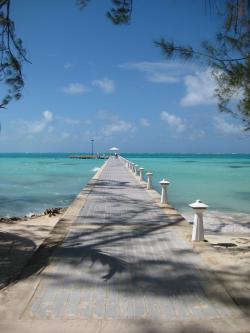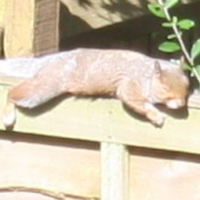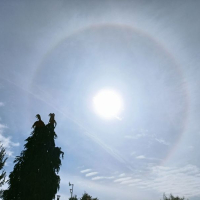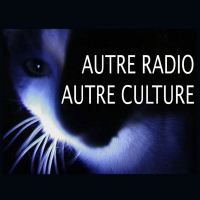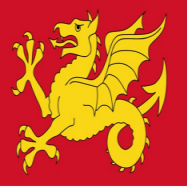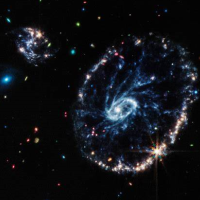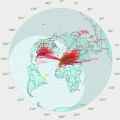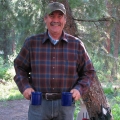jks
About
- Username
- jks
- Joined
- Visits
- 36,738
- Last Active
- Roles
- Member, Administrator, Moderator
- Points
- 670
Reactions
-
v1.813
From the CHANGE_LOG file:
v1.813 June 14, 2025
SNR measurement changes: (thanks VA3ROM et al)
Additions to admin control tab, SNR section:
New measurement intervals: 1, 5, 10 minutes and custom interval.
Remaining minutes to next measurement shown.
One custom band definition with frequency/zoom fields.
Checkbox to also measure ham bands and AM broadcast band.
Checkbox to force measurement after an antenna change.
Discussion:
The custom band, if setup, is added to the current default bands appearing in the
my_kiwi:8073/snr query JSON result. There is no user interface feedback if you enter
invalid values into the custom band fields. So check your combination of freq lo/hi and zoom
carefully to make sure they result in a freq range that fits entirely within a single
waterfall span. Otherwise the custom band will be ignored and not appear in the JSON result.
The ham/AM band checkbox adds all 12 ham bands and the AM broadcast band to the JSON result.
The ITU setting determines the upper freq limit of some bands (e.g. 40m 7200 vs 7300 kHz,
AM BCB 1602 vs 1700 kHz).
When "measure on antenna change" is active there is a 5 second delay after the last antenna
selection before the measurement starts.
JSON output changes to the /snr URL interface:
The measurement interval field "ihr" (hours) is now "imin" (minutes).
A new field "ant" shows the antenna that was selected when the measurement was made.
A value of zero means antennas are grounded or the antenna switch is not configured.
Note that for antenna mixing setups only the last antenna switched is given. Not all the
antennas cumulatively.
Changes to support camp mode by kiwirecorder: (thanks Ben)
You may know that when all channels are full, and you try to connect, you are presented with
a camp/queue panel that allows you to "camp" onto another listener's channel and hear what
they are hearing. But without being able to control anything (except volume/mute).
Kiwirecorder now has this capability. Changes were needed on the Kiwi side to support this.
The envisioned use case is as follows. You have an application running on another computer
that processes streamed audio via the netcat option of kiwirecorder. But you want to use
a regular Kiwi connection and its full user interface. You just want the netcat stream to
"follow" what the Kiwi UI is hearing so your external application can process the same audio.
An example of such an application might be a modulation classifier that could never run on
the Kiwi itself due to the limited processing power of the Beagle. To achieve this you
simply tell kiwirecorder which Kiwi channel number to camp on. In camp mode kiwirecorder
will do this instead of making a new, separate connection to the Kiwi. Communication over a
separate stream back to the Kiwi with application results is still to be implemented.
Fixed problem with Debian 11 upgrade function on admin backup tab. (thanks 2E0SXX)
DRM extension: Improved sorting when station schedules are displayed by time.
Fixed bug preventing timezone setup when only source of lat/lon was IP address geolocation info.
-
v1.805
From the CHANGE_LOG file:
v1.805 March 9, 2025
Mobile improvements:
Keyboards shortcuts work again, e.g. a Bluetooth keyboard connected to iPad. (thanks DL3LED)
Popup keyboard dismissed properly after "return" key pressed (e.g. on "ident" fields)
Disabled input field auto complete, auto correct, auto capitalize.
Antenna switch:
Buttons now turn green for Kmtronic-2ch switch. (thanks Fernando)
Multiuser/mixing denial notification working again. (Thanks Steffen)
CW Skimmer extension: New. But consider it experimental as there are a number of problems.
SSTV extension: Fixed MP mode height issue. (thanks VK3HK, VK3KHZ)
DX label filter panel: Reset button now clears ident & notes fields.
Update to satellite table to reflect recent Galileo changes. (thanks F4FPR)
-
v1.801
From the CHANGE_LOG file:
v1.801 February 5, 2025
Admin page: Now works on small-screen devices. The admin page will now scroll left/right and
up/down to display the full content that you would normally see using a desktop browser.
The layout of the admin content is the same as for desktop. The browsers on older devices
(e.g. iPad 2) will not work with this scheme and cannot be fixed. Please use a newer device.
There will no doubt be small problems and details to be worked out with this new feature.
Small-screen support for user connections is much more difficult and still TBD.
Added support for iframe content to tune Kiwi (i.e. frequency, passband, mode, zoom).
Try new entry "DX spots" in extension menu.
Added SK6AW.net DX spots as the default iframe content if no prior iframe configuration
had been setup. When you click on a spot frequency the Kiwi tunes and sets the mode.
If your Kiwi needs to be configured for this open the admin extensions tab and select
the iframe entry. Enter "URL" in the Source menu. Enter "https://spots.kiwisdr.com" in the
URL field. Enter "DX spots" in the Extension menu entry field. Check the box
"Allow iframe to tune Kiwi". If you already reference SK6AW.net directly please change to
spots.kiwisdr.com to get the new tuning functionality. (thanks HB9TMC, DF6DBF)
Select default antenna if antenna grounded from "ground when no users" mode when:
1) Connection made from a non-Kiwi app like kiwirecorder, TDoA etc.
2) SNR measurement occurs, including via URL or measure button on admin page. (thanks F5LFE)
Option for RF attenuator slider/buttons to send arbitrary shell command instead of adjusting
internal attenuator. E.g. a curl command to control external attenuator hardware.
Attenuator UI permissions still apply. See admin config tab for details. (thanks S57RW)
Fixed bad bug that restarts the proxy client when a non-proxy (e.g. local) admin connection
switches from any non-connect tab to the connect tab. This causes all user connections
using a proxy connection to get dropped. Can't believe this wasn't discovered sooner!
ALE:
During scanning the browser user interface focus will remain with the ALE extension.
This means changes to the controls and cut/paste in the output window will not be disturbed.
(thanks DK9FI)
Added "KFOR" to milcom frequency list. (thanks Mark W)
SSTV:
Added "save images" button. Saves current image bar as a browser .jpg download file.
(thanks barneyuk)
FT8:
Show total decode count. Cleared with "clear" button.
Fixed broken ft8_lib URL on control panel.
FSK:
Fixed broken custom shift menu setting.
Added SUBCOM VLF freqs to DX community database and FSK Milcom menu.
(thanks Paulus via x.com/ParssinenPaulus/status/1865520723298533678)
IBP:
Added URL parameters and help button content. This means IBP DX label entries can
specify these parameters to customize the IBP function when the label is clicked.
For example, enter "ibp,all" in the label "extension" field to make IBP select the
"All bands" menu entry when any IBP label is clicked. (thanks VK3KHZ)
Fixed URL used for short-wave.info from right-click menu SWBC database lookup. (thanks smg)
Fixed grid layout of DX label control panel.
Fixed display of community database labels that have time/day-of-week info.
Show Debian version in user control panel, stat tab.
IP address blacklist update. (thanks Thierry et al)
Added code to remove latest Linux virus. (thanks Mike)
Added QZSS sat QZS-6. (thanks Yogicat)
-
Audio timing walkabout [FT8 decoder problems solved with tighter limits on audio buffering]
So the problem here is that FT8 has a much greater time synchronization requirement (i.e. "wall clock" time) than WSPR does. The timing of the audio hitting FT8 must match what time the FT8 program is getting from the host operating system within a second or two at most.
The Kiwi produces a delay in the audio stream because it has some buffering. Buffering is required because it is the only defense against latency/interruption issues in the network, particularly when the audio is being delivered by the Internet over long distances with lots of potential points of interruption. So you are already being disadvantaged by the time delay of this buffering to begin with. Any additional cumulative delay by other software behaving badly (e.g. sample rate compensation by the VAC) may push the total timing over the FT8 limit.
One thing you could try is reducing the Kiwi buffer size to reduce the fixed delay. The penalty for doing this is that you will have much less immunity to short-term network interruptions. That means it's important to make sure there are no highly variable latency devices in the path between the Kiwi and computer running the browser, like a WiFi router or a cheap Ethernet switch that might behave badly with heavy traffic on the other ports.
Add "abuf=n.nn" to the URL where n.nn is a number in seconds of the minimum audio buffer size. Start with 0.5 and experiment with a range from 0.3 to 0.8
It would also be interesting to know on the control panel "Stats" tab what the value of the Audio "Qlen" (queue length) is when you are having problems versus what the value is when starting (this value will vary when the abuf= value is changed) -
v1.823, 824
From the CHANGE_LOG file:
v1.823 November 16, 2025
DX label frequency list menus:
When click-holding on a DX label a menu will now appear if there are multiple labels that
have the same label text. The menu allows the frequencies of these multiple labels to be
selected directly. This works for all the label databases: stored, EiBi and community.
Example: Click-hold on the 10 MHz WWVH/WWV label and a menu with all the WWV frequencies
(2.5, 5, 10, 15, 20 MHz) appears. A menu entry "open ext" will be shown if a label has an
associated extension. If a label only has a single frequency (e.g. WWVB, DCF77) click-holding
will immediately open the extension (if any). Type 'h' with the cursor in the label area for
a complete description.
Updated to EiBi-B25 database. (thanks MeolsKopite)
Proxy service: The proxy service client (frpc) is now managed in its own process such that it
will better respond to timeout / restarts when the Kiwi restarts faster then the network router.
For example after a power failure.
When the current frequency is exactly between adjacent or overlapping bands the frequency step
buttons now make more sense. Example: Current frequency is 7300 kHz when in ITU R2 (Americas)
mode where the 40m amateur band ends, and the 41m broadcast band begins, at 7300.
Previously the leftmost "-" step button (or 'alt-j' shortcut key) would step down -5 kHz into
the amateur band instead of -1 kHz as it should. (thanks Steffen)
Admin GPS tab:
Checkbox "Acquire if Kiwi busy?" now defaults to checked (true) for a new Kiwi run for the
first time. This change will not disturb any change to the setting you may have made using
the admin interface. (thanks NU6F)
Added SBAS satellites for development purposes. No SBAS corrections are currently done.
TDoA: Changed timeout value so message "Timeout: excessive runtime" will appear instead of the
more obscure "Protocol timeout" when the TDoA algorithm runs too long.
Added IP address to the "denied connection" log messages triggered by bots. (thanks F5LFE)
-
v1.822
From the CHANGE_LOG file:
v1.822 September 28, 2025
Antenna switch:
Use the "\+" escape sequence where you need a plus sign ('+') to appear in the curl fields.
Example "192.168.1.222?cmd=ant+1\+2+on" gives "192.168.1.222?cmd=ant 1+2 on"
Note that '+' alone gives a single space as before. (thanks IW2NKE)
Debugging mode added to ant-switch-frontend script. Preface any command with 'd' to enable.
E.g. "d s" to query switch status with curl debugging ("--verbose") enabled. Also sets
script "DEBUG" variable which individual scripts can use to trigger debugging actions.
The "ad" alias helps with this e.g. "ad s" instead of "./ant-switch-frontend d s"
SSTV extension: Works on 3-channel mode Kiwi again. (thanks nitroengine)
The server will now run and allow you to connect as admin even if the Kiwi board is broken
(e.g. FPGA not responding) or not installed. The FPGA communication failure LED pattern is
then appended to the IP address LED pattern in this case (see: kiwisdr.com/info/#id-fpga)
-
v1.807,808
Instructions for the Debian 11 upgrade procedure described below are here: http://kiwisdr.com/quickstart/index.html#id-D11-upgrade
From the CHANGE_LOG file:
v1.807,808 April 10, 2025
Admin backup tab: Added button to create a Debian 11 upgrade SD card which includes all
customizations from the current Kiwi. Intended to be used by Kiwi's still running Debian 8.x
Greatly simplifies the upgrade process by automating these formerly manual tasks:
Checks for sufficient free disk space.
Downloads Debian 11 image file from kiwisdr.com with integrity check (checksum).
Writes image to SD card.
Copies configuration from Kiwi's kiwi.config directory to SD card.
SD card is now ready to be use to re-flash this Kiwi to Debian 11 on the next restart.
Including if you were to immediately restart after the sd card creation completes.
=> Everyone is strongly advised to upgrade to Debian 11 from Debian 8.
At some point we will no longer provide software updates to Kiwi's running Debian 8.
Complete rewrite of the admin webpage grid & location processing code. (thanks studentkra)
FSK extension: Added preset menu. Complements the existing ability to set presets in the URL.
Reduced minimum name/callsign (ident) length from 16 to 8 characters. (thanks LIN)
Admin status & antenna switch configuration page now displays antenna status. (thanks LIN)
Updated to EiBi-A25 database. (thanks jgreentn)
External extensions being present will always cause a compile from source. (thanks DL3LED)
-
Find your Kiwi using my.kiwisdr.com
Got a Kiwi (running v1.330+) on your local network with an unknown local IP address? Like a new Kiwi out-of-the-box? Now from a browser on the same local network you can connect to my.kiwisdr.com and be automatically redirected to the Kiwi. The local IP address of the Kiwi will then show in the browser address bar.
This feature is similar to that provided by other IoT devices. It requires that the Kiwi have access to the Internet when it starts up. And that the computer running the browser is on the same local network as the Kiwi. If there are multiple Kiwis on the network the browser will display a table of Kiwis by serial number and a link that will connect to each one.
Our documentation lists 5 different methods of determining a Kiwi's IP address. But each has its limitations and disadvantages. Now there is a sixth method that is particularly convenient.
If you want to opt-out of your Kiwi sending this information to kiwisdr.com each time it starts then set the switch on the network tab of the admin page to NO: "Register this Kiwi on my.kiwisdr.com on each reboot?".
This feature has not been tested with IPv6 or mixed IPv4/IPv6 local networks. So there is likely some debugging required. -
Forgot your admin password? v1.803+ has an admin password reset feature
Okay, I think the new admin password reset scheme is working well. See image below.
The option will appear only if you connect from your local network. Not from an Internet connection (e.g. not from a Kiwi-2 serial number based proxy connection:
2xxxx.proxy.kiwisdr.com/admin). Usemy.kiwisdr.comto find the local IP address link to your Kiwi's admin page (e.g.192.168.1.101:8073/admin).You must also provide the Kiwi's serial number. This should be easy since it's written on the physical hardware (Kiwi-1: written in the white box on the Kiwi PCB, Kiwi-2: written on a label on bottom of case).
As a further security measure the option will only appear for the first 5 minutes after the Kiwi software starts (power-up or software restart).
So the restrictions should guarantee the Kiwi is in your immediate physical control. So no good for your remote Kiwi located 300 km away on a mountain top.
If anyone can think of a flaw in this reasoning please let me know ASAP.
Everything is carefully validated on the server-side. So anyone hacking Javascript on the browser shouldn't be able to exploit the scheme.
-
v1.809
From the CHANGE_LOG file:
v1.809 April 5, 2025
The output from my.kiwisdr.com has been expanded to include additional information:
Proxy links in addition to local IP links if proxy mode is setup and running.
Connection type & status (i.e. settings on admin page "connect" tab).
Kiwi and Debian software versions.
Kiwi product model and Beagle type.
The Debian hostname is shown after the serial number if it has been customized from the
default "kiwisdr". Useful if you have multiple Kiwi on your network and you want to
distinguish them by name instead of solely by serial number.
Admin network tab has new field "Debian hostname" to complement the my.kiwisdr.com change above.
This changes the actual Linux hostname and is not just a Kiwi configuration parameter.
DX label fixes (desktop):
When an extension is open, and you click on a dx label specified to open the same named
extension, the extension won't get closed and re-opened. Instead, any new extension
parameters contained in the dx label are sent directly to the open extension for
further processing. Example: clicking on a different LF time station causes the
timecode extension to change its decoding setup.
Label only turns magenta (indicting extension will be opened on click) when mousing over
label _without_ a modifier key pressed (shift etc). For example shift-clicking a label
opens the label edit panel. So it doesn't make sense to be turning the label magenta
because an extension isn't going to be opened when you click it.
The DX help panel is opened if the cursor is in the label area and "h" or "?" pressed.
The stored DX database can now have a custom name, 15 chars max. (thanks Mauno WRTH)
Change the first line of the dx.json file from:
{"dx":[
to:
{"my-custom-name":[
If this is of interest you presumably already have a custom dx.json file you're loading
via the admin DX tab "import JSON" button. If not, just use the "export JSON" button
to download a copy of dx.json and use a text editor to make your changes.
The custom name will appear in all the usual places: The left end of the frequency
scale, the various database selection menus, etc.
When frequency scale offset is in use (i.e. using a downconverter) fixed broken behavior of:
"VFO A/B" button. (thanks F5AFY)
"Zoom-to-band" button.
"--- +++" buttons when frequency scale offset was not a multiple of 1 kHz.
S-meter URL query: Allow optional mode e.g. my_kiwi:8073/s-meter?14200usb (thanks F5AFY)
Prevent Beagle LED control conflict when admin backup function running. (thanks F5AFY)
Save/restore waterfall timestamp parameters in browser storage. (thanks nitroengine)
Removed debugging print causing lots of "AJAX_STATUS ..." messages in admin log when
wsprdaemon or similar application are in use. (thanks DL4ZBE)
Admin local blacklist now disallows entry of subnets which would otherwise exclude local
network addresses or the loopback IP address. (thanks G2YT)
When the "device preset" menu of the "Mouse wheel / trackpad setup" section of the user tab
is set to anything except "custom" the three fields below are disabled for input.
Although they still show what the preset values are. (thanks ZL2P)
